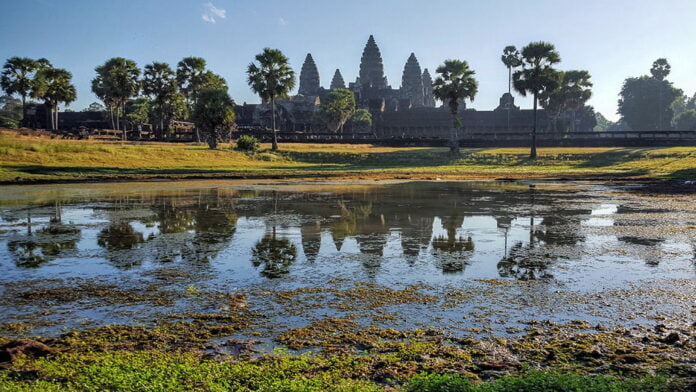Angkor Wat is the reason most visitors come to Cambodia. The largest religious monument in the world, it is arguably one of the most important and visually stunning attractions in Asia. Even though it is surrounded by a beautiful forest, and numerous other impressive and intriguing temples, Angkor Wat dominates the Angkor Archaeological Park and provides an awe-inspiring example of the brilliance of Khmer art and engineering.
5 fascinating facts about Angkor Wat
1. The Angkor Wat moat is not just there for security, water source, or even aesthetic value. The moat forms part of a complicated groundwater system (that includes the big reservoir – or Baray to the north of the Angkor Park) that helps stabilize the temple foundations through seasonal flooding and drought.
2. The stairs at the central sanctuary (now covered by wooden steps) are supposed to be steep as a reminder that you should ascend towards the place of the gods on your knees.
3. Construction of Angkor Wat took approximately 40 years. To give some perspective, the construction of Notre Dame Cathedral in Paris – built around the same time – took 182 years.
4. Angkor means “city” and Wat means “temple” – so Angkor Wat literally means “City Temple”.
5. Opinions vary about the inspiration for Angkor Wat’s design. Some say the five peaks are based on Holy Mount Meru, some on lotus flowers, some focus more on the overall design which has been thought to either reflect a universe in miniature, or the pervasive yoni and linga symbols replicated throughout Angkor.
5 handy hints for visiting Angkor Wat
1. If you head to Angkor Wat for sunrise – be patient! As the sky gets light, some people are disappointed and leave the area, thinking there will be no full sunrise – only to find that if they had stayed a little longer they would have seen the lazy orange sun rise over the moat and across the towers.
2. Make sure you wear light, loose-fitting clothing that covers your knees and shoulders. Anyone without their shoulders and knees covered will not be allowed into the central sanctuary. It is also considered disrespectful by most Cambodians to show off a lot of skin at a religious site.
3. If you are looking for a little peace and quiet to enjoy the majesty of the temples away from the crowds, head to the East gate. The grassy area here is a nice place to sit in the shade and enjoy the atmosphere.
4. Most people head for lunch at the temples between 11.30am and 2pm. This is a great time to visit Angkor Wat’s central sanctuary to avoid long queues and to enjoy a quieter experience.
5. Unsure whether to visit Cambodia in the rainy season? One of the advantages of the rains is that they fill the moat and the pools at Angkor Wat, making the landscape even more beautiful. Put a rain poncho in your bag, and head out the door early to ensure you enjoy the sight of the water without getting wet!
Angkor Wat History
Angkor Wat was constructed during the reign of Suryavarman II – a militarily aggressive King, who reigned from 1113 AD to around 1150 AD. As well as Angkor Wat, Suryavarman II is credited with constructing Beng Melea and Banteay Samre temples.
Angkor Wat is dedicated to Vishnu, and is orientated to the west – leading many experts to believe that it is a funerary temple. It was abandoned some years after Suryavarman II’s death, when Jayavarman established a new state capital at Angkor Thom. However, there has been a small population living within the Angkor Wat area almost up until the present day. The moat protected it to a certain extent from being totally overtaken by the jungle (unlike Ta Prohm) and there were monks living in and around the temple for many years, as well as the walls providing some shelter for refugees during the civil war.
Angkor Wat was “discovered” by António da Madalena in 1586, but global awareness of the temple was really created through the travel writings of French explorer Henri Mouhot in the mid 19th century. The site was listed as a World Heritage Site in 1992 and from that time restoration work has been ongoing.
Architectural design
Most people enter Angkor Wat from the impressive western causeway – a wide terrace that crosses the 200m wide moat and leads to the main entrance. Visitors then reach the outer wall which runs at 1025m by 800m. Within the wall, you find another causeway, two libraries, and the remains of two pools. Past the pools, you reach the central temple structure. This is designed on three levels. Each level encloses a square surrounded by linked galleries. The third level is the most impressive, and, at the time of building, was only accessed by the King and the high priest. Standing 42m high, it gives amazing views over the Angkor Park, and is architecturally interesting in itself. It’s a steep climb up but well worth it.
Bas reliefs
One of the attractions of Angkor Wat for many visitors is the array of well-preserved bas-reliefs (wall carvings) covering its walls. Throughout the temple you can find many carvings of apsaras and devatas, but it is the large reliefs that depict whole stories that attract the most attention. Three of the most famous are the reliefs depicting the Battle of Kurukshetra, the Churning of the Ocean of Milk, and the Army of Suryavarman II.
The Battle of Kurukshetra
Situated in the south part of the west gallery, this panel visualizes the battle of the Hindu Mahabharata. Some sections look like black marble – but this is just polishing from centuries of visitors who have traced the figures with their fingers.
Churning of the Ocean of Milk
Perhaps the most famous bas-relief at Angkor Wat, this is situated in the southern section of the east gallery and depicts gods and demons churning the sea to extract the elixir of immortality.
The Army of Suryavarman II
In the west part of the south gallery, you can learn more about the king who constructed Angkor Wat, and his idea of his own military prowess (which he is considered to have somewhat overstated). These two panels present foot, soldiers, offers, commanders and finally Suryavarman II on an elephant.




Hi, can we go at the top level of Angkor Wat as early as 6am?
Hi, the central tower only opens at 7.30am. I’ve noticed a few times that tourists are allowed to go up earlier after paying some tea money to a security guard, but i wouldn’t encourage this behavior.